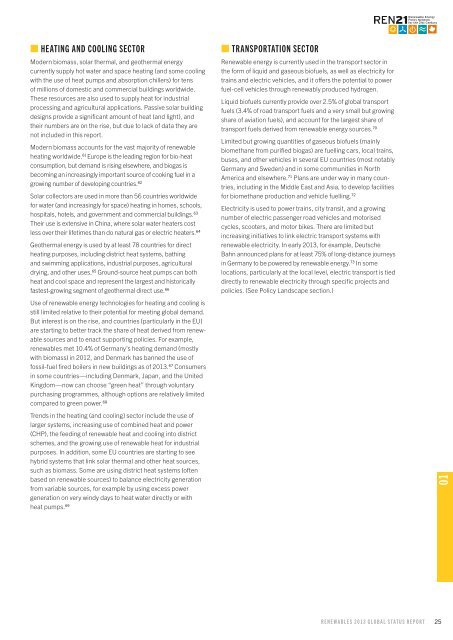RenewableS 2013 GlObal STaTUS RePORT - REN21
RenewableS 2013 GlObal STaTUS RePORT - REN21
RenewableS 2013 GlObal STaTUS RePORT - REN21
You also want an ePaper? Increase the reach of your titles
YUMPU automatically turns print PDFs into web optimized ePapers that Google loves.
■■Heating and Cooling Sector<br />
Modern biomass, solar thermal, and geothermal energy<br />
currently supply hot water and space heating (and some cooling<br />
with the use of heat pumps and absorption chillers) for tens<br />
of millions of domestic and commercial buildings worldwide.<br />
These resources are also used to supply heat for industrial<br />
processing and agricultural applications. Passive solar building<br />
designs provide a significant amount of heat (and light), and<br />
their numbers are on the rise, but due to lack of data they are<br />
not included in this report.<br />
Modern biomass accounts for the vast majority of renewable<br />
heating worldwide. 61 Europe is the leading region for bio-heat<br />
consumption, but demand is rising elsewhere, and biogas is<br />
becoming an increasingly important source of cooking fuel in a<br />
growing number of developing countries. 62<br />
Solar collectors are used in more than 56 countries worldwide<br />
for water (and increasingly for space) heating in homes, schools,<br />
hospitals, hotels, and government and commercial buildings. 63<br />
Their use is extensive in China, where solar water heaters cost<br />
less over their lifetimes than do natural gas or electric heaters. 64<br />
Geothermal energy is used by at least 78 countries for direct<br />
heating purposes, including district heat systems, bathing<br />
and swimming applications, industrial purposes, agricultural<br />
drying, and other uses. 65 Ground-source heat pumps can both<br />
heat and cool space and represent the largest and historically<br />
fastest-growing segment of geothermal direct use. 66<br />
Use of renewable energy technologies for heating and cooling is<br />
still limited relative to their potential for meeting global demand.<br />
But interest is on the rise, and countries (particularly in the EU)<br />
are starting to better track the share of heat derived from renewable<br />
sources and to enact supporting policies. For example,<br />
renewables met 10.4% of Germany’s heating demand (mostly<br />
with biomass) in 2012, and Denmark has banned the use of<br />
fossil-fuel fired boilers in new buildings as of <strong>2013</strong>. 67 Consumers<br />
in some countries—including Denmark, Japan, and the United<br />
Kingdom—now can choose “green heat” through voluntary<br />
purchasing programmes, although options are relatively limited<br />
compared to green power. 68<br />
Trends in the heating (and cooling) sector include the use of<br />
larger systems, increasing use of combined heat and power<br />
(CHP), the feeding of renewable heat and cooling into district<br />
schemes, and the growing use of renewable heat for industrial<br />
purposes. In addition, some EU countries are starting to see<br />
hybrid systems that link solar thermal and other heat sources,<br />
such as biomass. Some are using district heat systems (often<br />
based on renewable sources) to balance electricity generation<br />
from variable sources, for example by using excess power<br />
generation on very windy days to heat water directly or with<br />
heat pumps. 69<br />
■■TransportATION Sector<br />
Renewable energy is currently used in the transport sector in<br />
the form of liquid and gaseous biofuels, as well as electricity for<br />
trains and electric vehicles, and it offers the potential to power<br />
fuel-cell vehicles through renewably produced hydrogen.<br />
Liquid biofuels currently provide over 2.5% of global transport<br />
fuels (3.4% of road transport fuels and a very small but growing<br />
share of aviation fuels), and account for the largest share of<br />
transport fuels derived from renewable energy sources. 70<br />
Limited but growing quantities of gaseous biofuels (mainly<br />
biomethane from purified biogas) are fuelling cars, local trains,<br />
buses, and other vehicles in several EU countries (most notably<br />
Germany and Sweden) and in some communities in North<br />
America and elsewhere. 71 Plans are under way in many countries,<br />
including in the Middle East and Asia, to develop facilities<br />
for biomethane production and vehicle fuelling. 72<br />
Electricity is used to power trains, city transit, and a growing<br />
number of electric passenger road vehicles and motorised<br />
cycles, scooters, and motor bikes. There are limited but<br />
increasing initiatives to link electric transport systems with<br />
renewable electricity. In early <strong>2013</strong>, for example, Deutsche<br />
Bahn announced plans for at least 75% of long-distance journeys<br />
in Germany to be powered by renewable energy. 73 In some<br />
locations, particularly at the local level, electric transport is tied<br />
directly to renewable electricity through specific projects and<br />
policies. (See Policy Landscape section.)<br />
01<br />
Renewables <strong>2013</strong> Global Status Report 25




